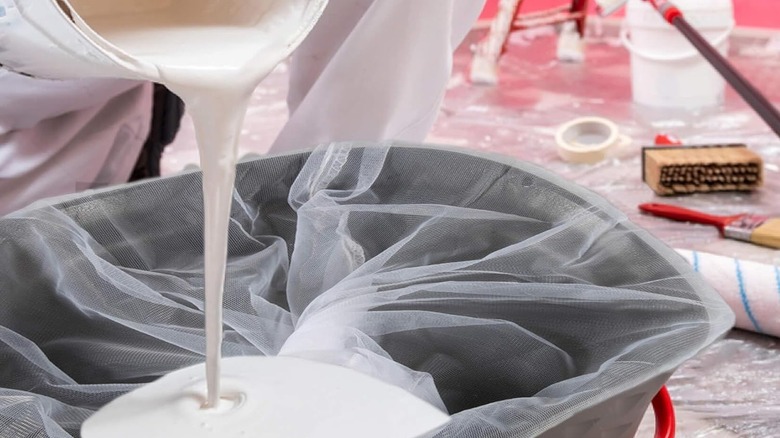Does The Sieve Hack To Restore Old Paint Actually Work?
We may receive a commission on purchases made from links.
If you've had paint sitting around in the can for some time, a skin will often form over the top, but there could be good, usable paint underneath. With even budget latex wall paints starting at upwards of thirty bucks a gallon – and considerably more for well-known brands or enamel and oil-based paints — you certainly don't want it to go to waste. The sieve hack is often suggested as a simple, money-saving solution to restore old paint, but does it actually work?
Well, the good news is that yes, it generally does. In fact, it's probably the best answer to that old question of what are paint boogers and how can you prevent them? Sieving (or straining) can restore old paint and will prevent lumps from transferring from your brush or roller to the surface you're painting. It is also widely recommended by professionals, even with new paint, as a way to avoid a clogged paint sprayer with one easy preparation step.
Sieving old paint may not be guaranteed to work every time, but given it takes little time or effort, it's certainly worth a try. So, will any old sieve do? Does it work with all types of paint? Are there other ways to help restore old paint? Let's find some answers.
The best ways to sieve and restore all types of old paint
If a skin has formed, cut it away carefully with a utility knife. If you have water-based latex, smell it first. If it's rancid, no amount of mixing or straining will help. Throw it away. This doesn't normally happen with oil-based paints. If either type of paint has separated, stir it to see if it will recombine. If it does, you can then sieve it.
The cheapest way to sieve paint is to use pantyhose, but it can be a bit hit and miss. There are efficient commercial products that are specifically designed to strain out lumps and debris, and they are not expensive. For example, Sukh Strainer Bags are just $7.99 for ten. They have an elasticated neck to fit over a five-gallon bucket and are disposed of after use. Steel strainers, like the Zhuitu Fine Mesh Paint Strainer, are usually under twenty bucks and are much more durable. So, they could work out cheaper in the long run and are arguably more eco-friendly. If the paint is particularly lumpy, try thinning it with a little water or spirit first and stirring. It won't always work, but it only takes moments to find out.
There are some simple ways to fix a botched paint job, but it's better to avoid as many problems as possible in the first place. The sieve hack to restore old paint can save you money and probably a lot of time and frustration, too.
